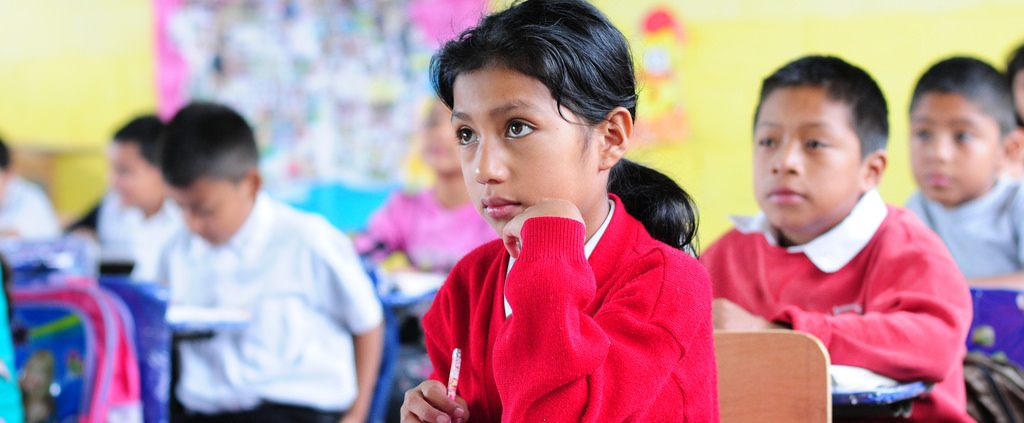Education amidst fragility, conflict and violence
By Steve Commins, Associate Director, Global Public Affairs @ UCLA Luskin Director, International Practice Pathway Faculty Cluster Leader, Global Environment and Resources, Lecturer in Urban Planning

Access to schooling and quality learning can be undermined by various manifestations of fragility, conflict and violence (FCV). The effect of different elements of FCV on education has both immediate and long lasting impacts on children’s learning, their well-being and their
future prospects.
In different forms, FCV manifestations contribute to a denial of the right to education, whether from government failures, a violent ecosystem, and the treatment of displaced children and divisions within schools, attacks on schools or the language of instruction. This can include the ways in which teachers and principals treat lower castes, children with disabilities, or minority groups; the threat or real violence against girls; as well as how textbooks portray history and culture. These issues exist globally, not just in ‘fragile states’.
Over the past two decades, greater attention has focused on the impact that long-term complex humanitarian emergencies, fragile states, and contexts of protracted crises on education. What has received less attention is the aggregate impact of various forms of negative conflict and intra-personal violence.
There are three entry points to consider for FCV: protracted crises; conflict as the basis of exclusion; direct and indirect forms of intra-personal violence.
The entry point that is more familiar in the donor system are protracted crises or fragile and conflict-affected States. When governments lack the capacity or commitment to support educational systems, there are notably fewer children in school, and when children are at school in these environments, frequently there are either no teachers or the schools lack the resources for effective learning.
In practical terms, the humanitarian aid system often, and of necessity, focuses first on saving lives. Thus, education frequently receives less support or priority in emergencies. However, when humanitarian crises are protracted, as is evident in the long-term displacement with its challenges of urban settings and large numbers, there is more room to build on the work of networks focused on education in emergencies.
What needs to receive more attention is the presence of widespread forms of exclusion based on negative conflict outcomes and violence in countries and regions not designated as ‘fragile’. This includes OECD countries where different manifestations of bullying, gangs, threats to enforce exclusion and corporal punishment also exist. The impact of the overall impact on education of different forms of violence may be significantly underestimated.
 Conflict and violence are distinct but related issues. Conflict is part of all societies at all levels, from household to state. There are many instances when conflict over resources, norms, access to power, is negatively resolved without violence but nevertheless leads to exclusion from education. This could involve deliberate mistreatment of indigenous children, instruction in the language of a dominant identity group, or preferential advantages to children from more powerful groups.
Conflict and violence are distinct but related issues. Conflict is part of all societies at all levels, from household to state. There are many instances when conflict over resources, norms, access to power, is negatively resolved without violence but nevertheless leads to exclusion from education. This could involve deliberate mistreatment of indigenous children, instruction in the language of a dominant identity group, or preferential advantages to children from more powerful groups.
In situations where the education system contributes to different forms of negative conflict (ethnic exclusion, gender exclusion, language of instruction), there will be reduced access to schools for certain groups as well as potential exacerbation of existing forms of conflict.
This is distinct from, but sometimes linked with, ecosystems of violence, both external to the school (gang violence) and within the school, bullying, sexual and gender-based violence (SGBV) and corporal punishment.
Just as the total number of people affected by ‘small’ disasters compared to mega disasters can be comparable, so the total number of children affected by forms of negative conflict and local violence may also be comparable to those affected by fragile and conflict-affected states’ contexts.
Governments, donors and civil society organizations can expand the definition of FCV to give greater attention to the conflict and violence elements. Program design can be structured more specifically to address pedagogical, community and classroom issues. There can be specific programs structured to reduce bullying, SGBV and corporal punishment.
Governance and fragility are still at the heart of the matter: Does the state have the capacity and will to deliver education to all children? Is the state reducing different forms of conflict-based exclusion? Does the state have enforceable laws against SGBV and corporal punishment?
Creating safe and effective learning environments remains central to achieving educational goals in all countries and contexts, and greater attention is required for both rebuilding and sustaining educational systems in fragile states, as well as to the neglected dimension of FCV briefly outlined in this note.
Additional resources:




